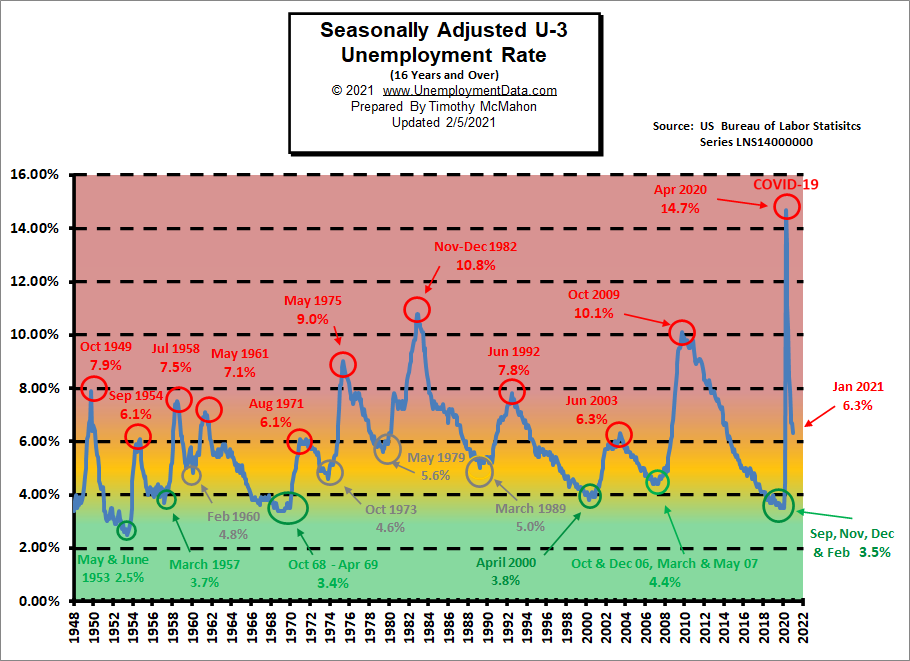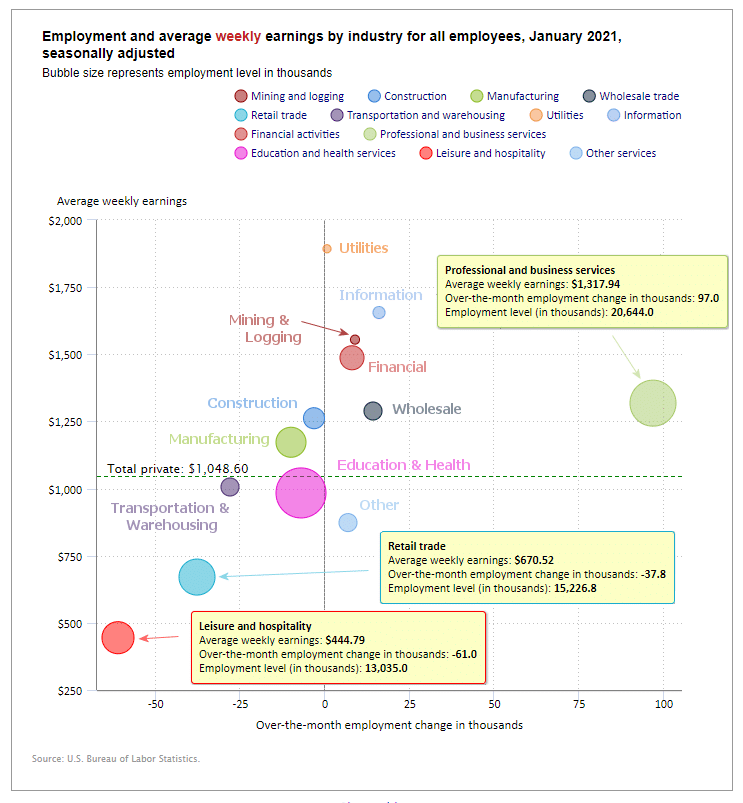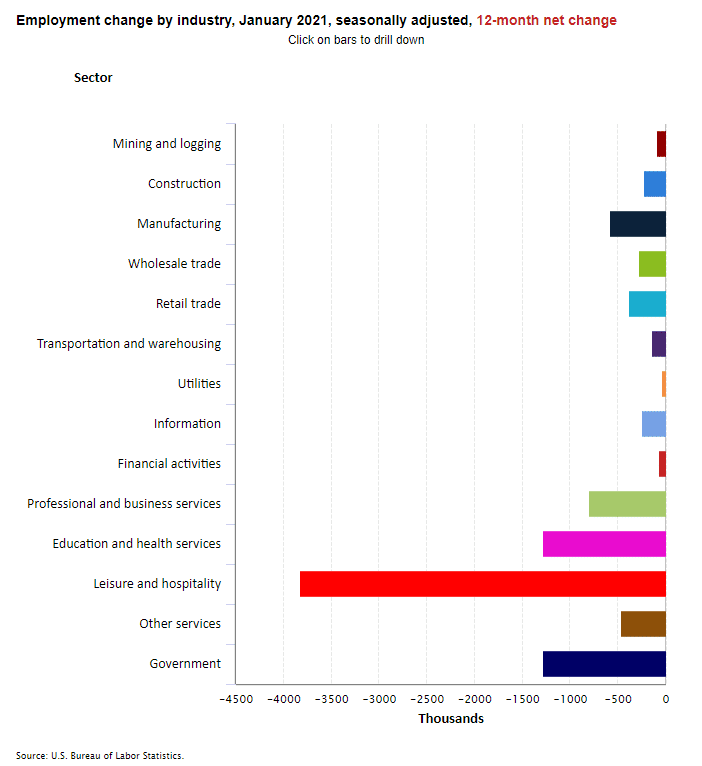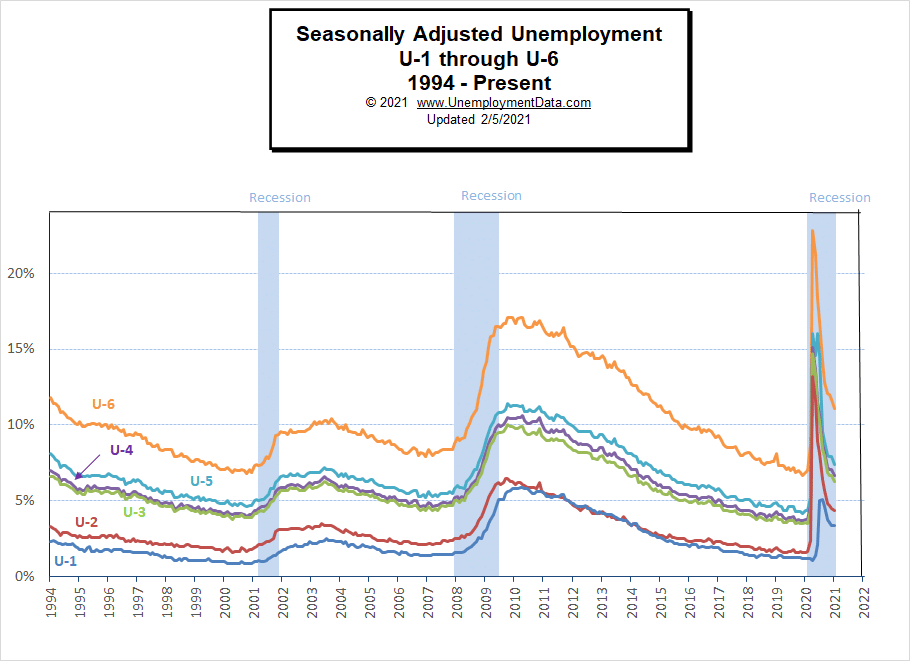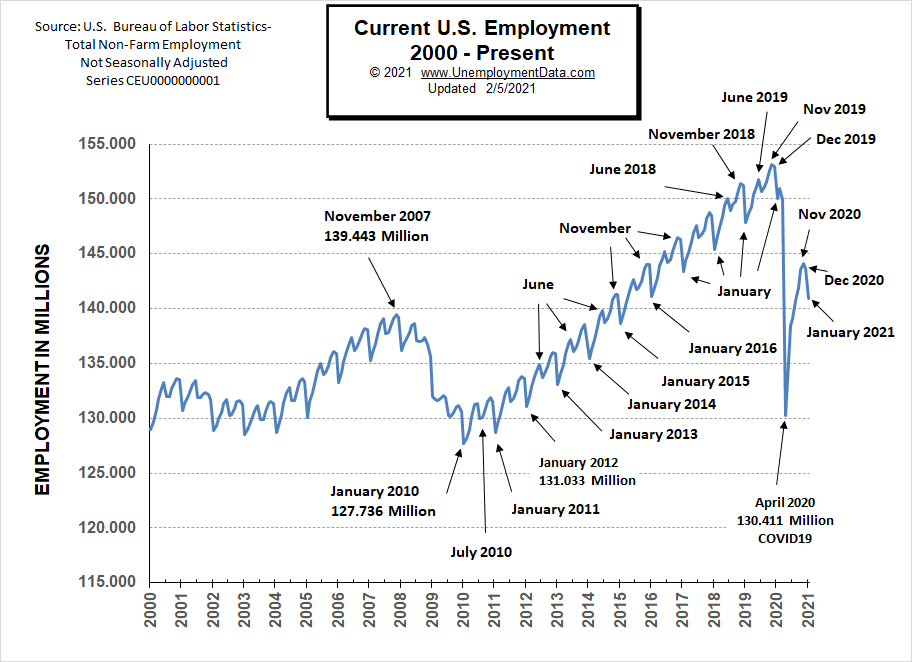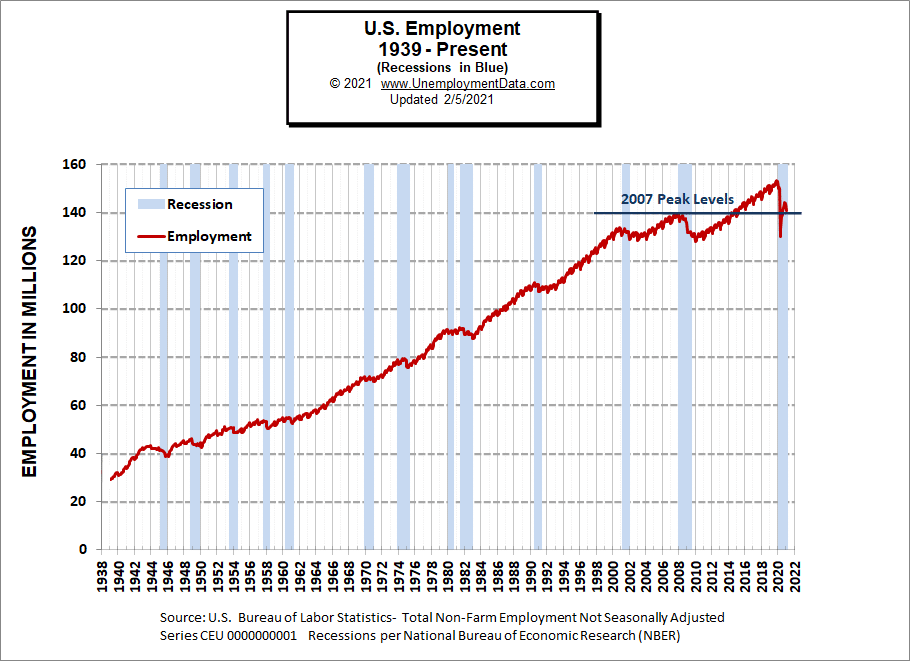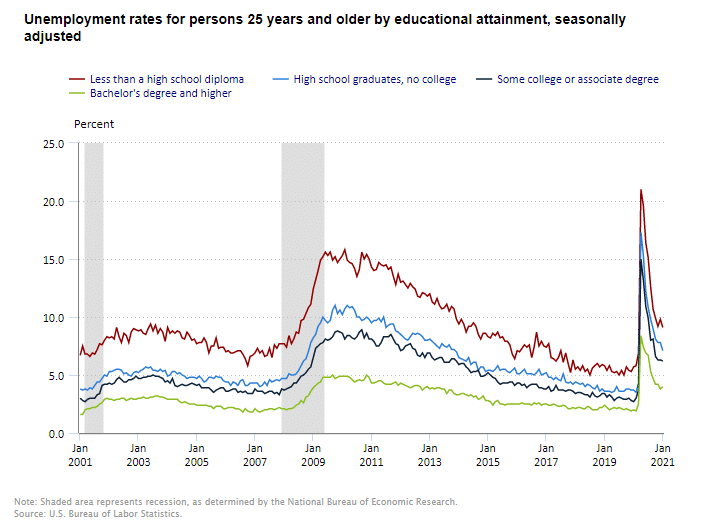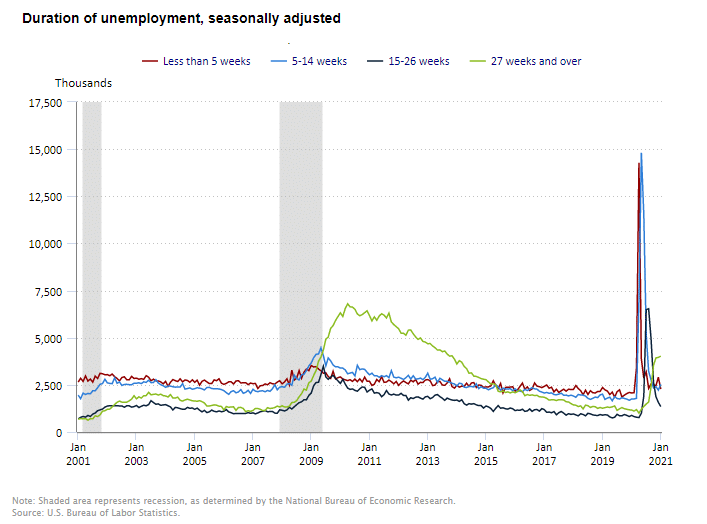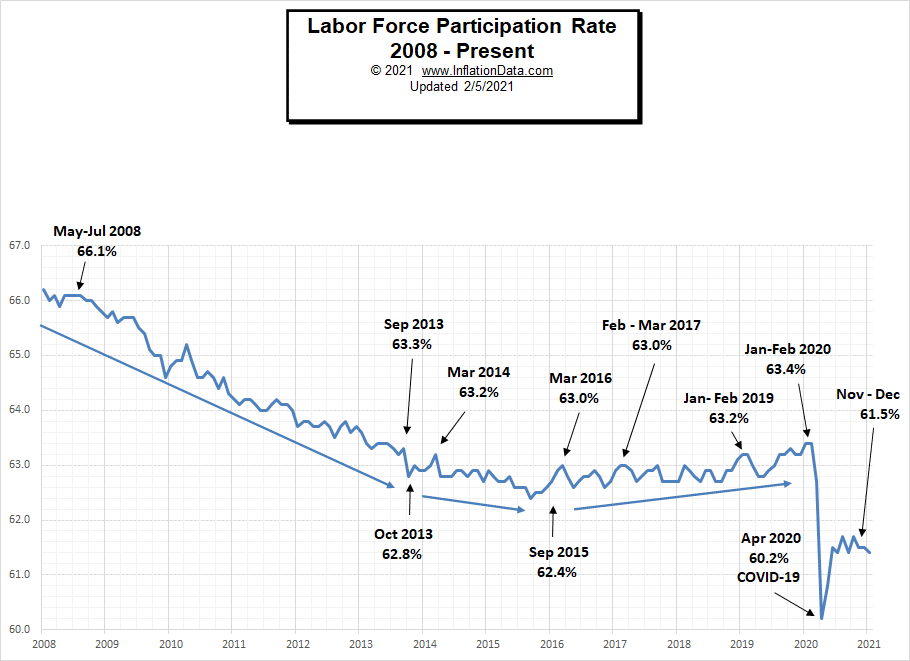Highlights from the Bureau of Labor Statistics (BLS) employment / unemployment report for January released on February 5th.
- Unadjusted U-3 was Up from 6.5% to 6.8%
- Adjusted U-3 was Down from 6.7% to 6.3%
- Unadjusted U-6 was Up from 11.6% to 12.0%
- Labor Force Participation was Down from 61.5% to 61.4%
- Unadjusted Employment Down from 143.700 million to 140.927 million
According to the Commissioner of the U.S. Bureau of Labor Statistics:
“The unemployment rate fell by 0.4 percentage point to 6.3 percent in January, and nonfarm payroll employment changed little (+49,000). The labor market continued to be impacted by the coronavirus (COVID-19) pandemic and efforts to contain it. Notable job gains in professional and business services and in both public and private education were offset by losses in leisure and hospitality, in retail trade, in health care, and in transportation and warehousing.”
Of course, they are talking about “Seasonally Adjusted Jobs” from the “Current Population Survey (CPS)” rather than looking at the results reported by actual companies in their “Current Employment Statistics survey (CES)”
But looking at the CES report we see…
Originally the BLS reported 143.777 million jobs for December, this month they adjusted that slightly.
So currently they are saying 143.700 million jobs for December and 140.927 million for January.
which is actually a decrease of 2,850,000 jobs based on their original estimates.
Unemployment Drops to Merely Bad
As we can see from the chart below when unemployment gets into the “red zone” things are really bad. But historically “Bad” for the U-3 usually starts at around 7% and stops at around 10% with only two previous occasions getting into the 10% range. But this time, due to COVID shutdowns, the U.S. economy went from really good (green zone) to really bad virtually overnight. The yellow zone is the normal operating range and it runs from about 4% to 6% and when unemployment stays in this range the economy is generally doing OK. Below 4% and the economy is doing great above 7% and the economy is in for trouble. Currently, the U-3 unemployment rate has fallen from the horrendous 14.7% of April down to the normally bad 6.3%. We have to remember that the PEAKS in 1954, 1971, and 2003 were at 6.3% and that was the worst it got. And that is why we’re saying unemployment went from being extraordinarily bad to only normally bad.
Employment by Sector
The employment “bubble chart” shows how each sector of the economy is doing (employment wise on a seasonally adjusted basis).
Typically January is the worst month with retailers and hospitality reducing seasonal staff. This year, roughly half of the sectors lost jobs (i.e. were to the left of the zero line), Leisure and Hospitality was the big loser -61,000 jobs followed by Hospitality which lost -37,000 jobs
But average weekly wages continued to rise to $1,048.60 in January from $1034.41 in December and November’s $1029.38
It was $1,026.60 in October, $1,022.61 in September, August was $1,019.66 and July was $1,013.96. So those who continue working appear to be improving.
(See the table below for details.)
How to read this chart:
The bubbles location on the chart tell us two things:
- Change in Employment Levels over the most recent month.
- Average Weekly earnings.
- The further to the right the bubble the larger the increase in the number of jobs.
- The higher up on the chart the larger the average salary.
Bubble Size tells us:
- Total Employment for the sector.
- Larger bubbles mean more people are employed in that sector.
Employment and Average Weekly Earnings by Industry
January 2021, Seasonally Adjusted
| Industry | Monthly Increase | Average Weekly Earnings | Employment Level |
| Total Private Employment | 6,000 | $1,048.60 | 121,123,000 |
| Mining and Logging | 9,000 | $1,554.60 | 609,000 |
| Construction | -3,000 | $1,261.92 | 7,392,000 |
| Manufacturing | -10,000 | $1,172.41 | 12,217,000 |
| Wholesale trade | 14,300 | $1,288.74 | 5,632,200 |
| Retail trade | -37,800 | $670.52 | 15,226,800 |
| Transportation and Warehousing | -27,800 | $1005.87 | 5,659,400 |
| Utilities | 600 | $1,893.04 | 539,100 |
| Information | 16,000 | $1,655.40 | 2,672,000 |
| Financial Activities | 8,000 | $1,487.05 | 8,782,000 |
| Professional and Business Services | 97,000 | $1,317.94 | 20,644,000 |
| Education and Health Services | -7,000 | $983.81 | 23,240,000 |
| Leisure and Hospitality | -61,000 | $444.79 | 13,035,000 |
| Other Services | 7,000 | $873.28 | 5,474,000 |
Another way to look at these monthly numbers. This one includes a decrease in government jobs and shows the magnitude of the loss in Leisure and Hospitality jobs.
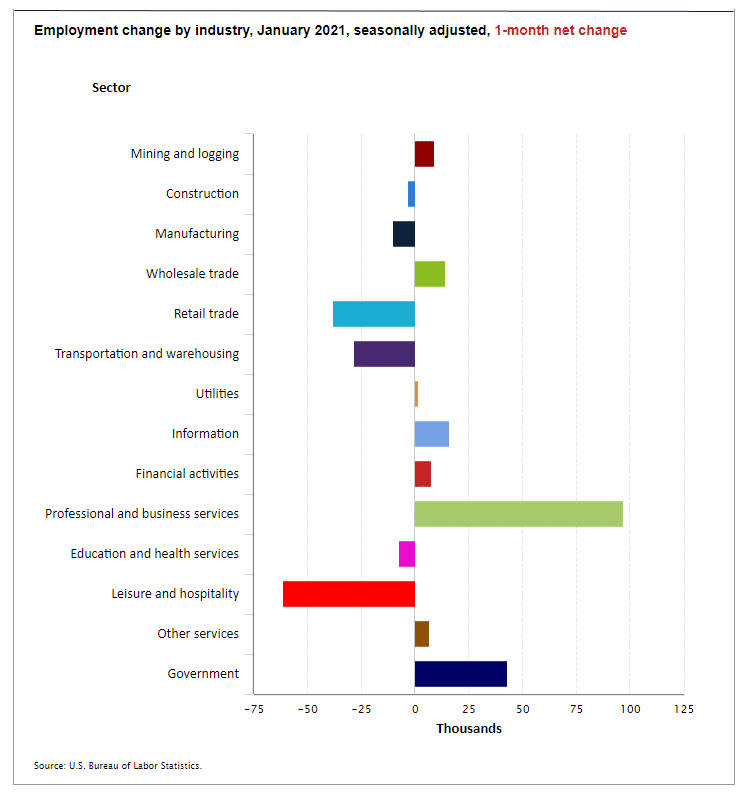
Source: BLS
U1 through U6 Unemployment Rates
Due to COVID, all the various measurements of Seasonally Adjusted Unemployment from U-1 through U-6 spiked up sharply beginning in April except U1 which measures unemployment longer than 15 weeks. In July, they began falling rapidly. In November they only fell slightly due to renewed restrictions by several states. And in December they were basically flat. In January most of the measurements fell slightly on a Seasonally adjusted basis even though they rose on a nominal basis.
For more information about the various measurements of unemployment see What Is U-6 Unemployment?
Current Employment
Typically the low point for each year occurs in January and then it moves almost straight up to a small peak around June with a slight drop around July and then the highest peak in employment happens in November with a slight decline in December. As expected January employment dropped sharply (perhaps a bit more sharply than typical). Hopefully, February will see the typical rebound.
Last year the COVID virus shortcircuited the normal trend with a drop that began in March and by April it had wiped out all the employment gains since July 2010. June 2020 saw employment rebound to approximately the January 2015 level. Fortunately, July did not follow the traditional falling pattern but instead rose (although only slightly). August’s employment rose to roughly the January 2016 level. September employment rose roughly triple the rate at which it rose in 2019. October’s employment rose to slightly above the January 2017 level. In December we got the traditional slight decline. And January got the expected sharp drop.
In November and December employment was still just over 9 million below year-ago levels and the civilian population has increased by more than a million people.
See Current Employment for more info.
Previous Record Low Unemployment (Seasonally Adjusted U-3)
If we consider anything 4% or below as “low” we have had a few “low” stretches as we can see in the table below.
(4% or below in Green)
| Jan | Feb | Mar | Apr | May | Jun | Jul | Aug | Sep | Oct | Nov | Dec | |
| 1950 | 6.5% | 6.4% | 6.3% | 5.8% | 5.5% | 5.4% | 5.0% | 4.5% | 4.4% | 4.2% | 4.2% | 4.3% |
| 1951 | 3.7% | 3.4% | 3.4% | 3.1% | 3.0% | 3.2% | 3.1% | 3.1% | 3.3% | 3.5% | 3.5% | 3.1% |
| 1952 | 3.2% | 3.1% | 2.9% | 2.9% | 3.0% | 3.0% | 3.2% | 3.4% | 3.1% | 3.0% | 2.8% | 2.7% |
| 1953 | 2.9% | 2.6% | 2.6% | 2.7% | 2.5% | 2.5% | 2.6% | 2.7% | 2.9% | 3.1% | 3.5% | 4.5% |
| 1954 | 4.9% | 5.2% | 5.7% | 5.9% | 5.9% | 5.6% | 5.8% | 6.0% | 6.1% | 5.7% | 5.3% | 5.0% |
| 1955 | 4.9% | 4.7% | 4.6% | 4.7% | 4.3% | 4.2% | 4.0% | 4.2% | 4.1% | 4.3% | 4.2% | 4.2% |
| 1956 | 4.0% | 3.9% | 4.2% | 4.0% | 4.3% | 4.3% | 4.4% | 4.1% | 3.9% | 3.9% | 4.3% | 4.2% |
| 1957 | 4.2% | 3.9% | 3.7% | 3.9% | 4.1% | 4.3% | 4.2% | 4.1% | 4.4% | 4.5% | 5.1% | 5.2% |
| 1958 | 5.8% | 6.4% | 6.7% | 7.4% | 7.4% | 7.3% | 7.5% | 7.4% | 7.1% | 6.7% | 6.2% | 6.2% |
| … | … | … | … | … | … | … | … | … | … | … | … | … |
| 1965 | 4.9% | 5.1% | 4.7% | 4.8% | 4.6% | 4.6% | 4.4% | 4.4% | 4.3% | 4.2% | 4.1% | 4.0% |
| 1966 | 4.0% | 3.8% | 3.8% | 3.8% | 3.9% | 3.8% | 3.8% | 3.8% | 3.7% | 3.7% | 3.6% | 3.8% |
| 1967 | 3.9% | 3.8% | 3.8% | 3.8% | 3.8% | 3.9% | 3.8% | 3.8% | 3.8% | 4.0% | 3.9% | 3.8% |
| 1968 | 3.7% | 3.8% | 3.7% | 3.5% | 3.5% | 3.7% | 3.7% | 3.5% | 3.4% | 3.4% | 3.4% | 3.4% |
| 1969 | 3.4% | 3.4% | 3.4% | 3.4% | 3.4% | 3.5% | 3.5% | 3.5% | 3.7% | 3.7% | 3.5% | 3.5% |
| 1970 | 3.9% | 4.2% | 4.4% | 4.6% | 4.8% | 4.9% | 5.0% | 5.1% | 5.4% | 5.5% | 5.9% | 6.1% |
| … | … | … | … | … | … | … | … | … | … | … | … | … |
| 1999 | 4.3% | 4.4% | 4.2% | 4.3% | 4.2% | 4.3% | 4.3% | 4.2% | 4.2% | 4.1% | 4.1% | 4.0% |
| 2000 | 4.0% | 4.1% | 4.0% | 3.8% | 4.0% | 4.0% | 4.0% | 4.1% | 3.9% | 3.9% | 3.9% | 3.9% |
| 2001 | 4.2% | 4.2% | 4.3% | 4.4% | 4.3% | 4.5% | 4.6% | 4.9% | 5.0% | 5.3% | 5.5% | 5.7% |
| … | … | … | … | … | … | … | … | … | … | … | … | … |
| 2018 | 4.1% | 4.1% | 4.1% | 3.9% | 3.8% | 4.0% | 3.9% | 3.9% | 3.7% | 3.7% | 3.7% | 3.9% |
| 2019 | 4.0% | 3.8% | 3.8% | 3.6% | 3.6% | 3.7% | 3.7% | 3.7% | 3.5% | 3.6% | 3.5% | 3.5% |
| 2020 | 3.6% | 3.5% | 4.4% | 14.7% | 13.3% | 11.1% | 10.2% | 8.4% | 7.9% | 6.9% | 6.7% | 6.7% |
| 2021 | 6.3% |
Historical Employment
Historically employment is closely tied to recessions and that is no accident. One of the primary factors in calculating whether the economy is officially in a recession is an increase in the unemployment rate. The chart below provides the Historical Employment Data overlaid on blue bars showing periods of official recessions. In April, the number of people employed fell below the 2007 peak, near the lows of the 2008-2010 crash. In August it rebounded back above the 2007 peak level. According to the National Bureau of Economic Research (NBER) we have officially been in a recession since February. Since they measure a recession beginning from the peak, that just means the economy is no longer growing, which is pretty obvious due to the virus.
See Historical Employment Data for more info.
Current Seasonally Adjusted Unemployment
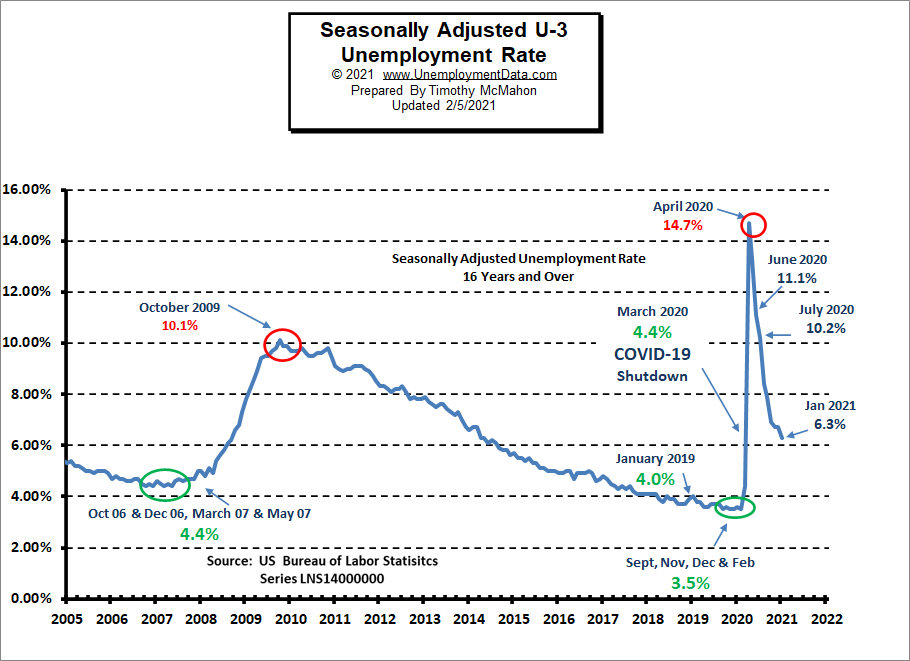
Unemployment by Education
Unemployment for those with less than a High School Diploma rose to 21.2% in April 2020, after bottoming at 4.8% in September 2019. It then fell to 15.4% by July and 9.8% in October to 9.0% in November. In December it rose back to 9.8% and fell to 9.1% in January.
Typically those with a Bachelor’s degree are relatively immune to unemployment. Although during the 2008 recession college grads’ unemployment rose to slightly above 4%.
Those with a Bachelor’s degree or higher had a low of 1.9% unemployment in February 2019 and rose to 8.4% in April 2020. Unemployment fell to 4.8% by September and 4.2% in October where it remained in November. It fell to 3.8% in December but rose back to 4% in January.
Source: Bureau of Labor Statistics
Reasons for Unemployment – Layoff Status
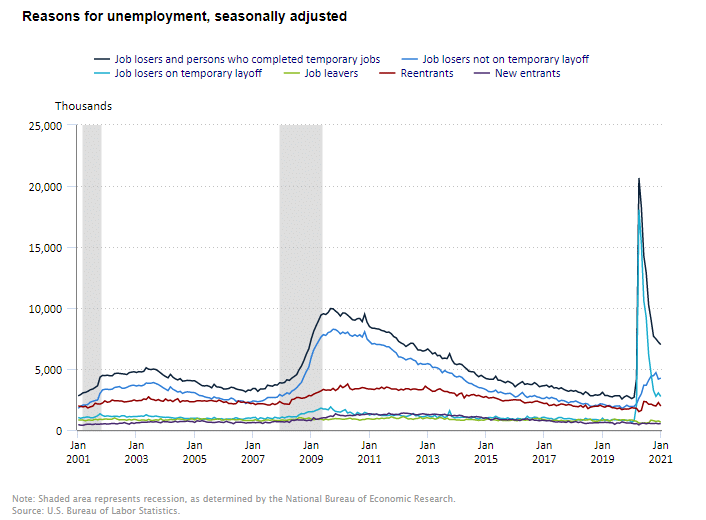
Source: BLS
Duration of Unemployment
In this chart, we can see the aftermath of the 2008 “Great Recession”, it took several years for long-term unemployment i.e. 27 weeks and over (green line) to return to the normal range and it wasn’t until 2016 that it fell below the shorter term unemployment levels.
If we look at the Duration of Unemployment since 2017 we can see the unprecedented shift from a healthy economy to the COVID economy of 2020.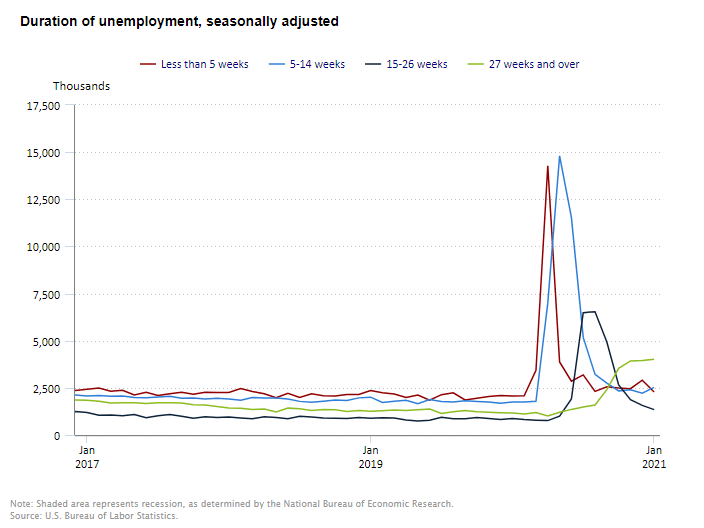
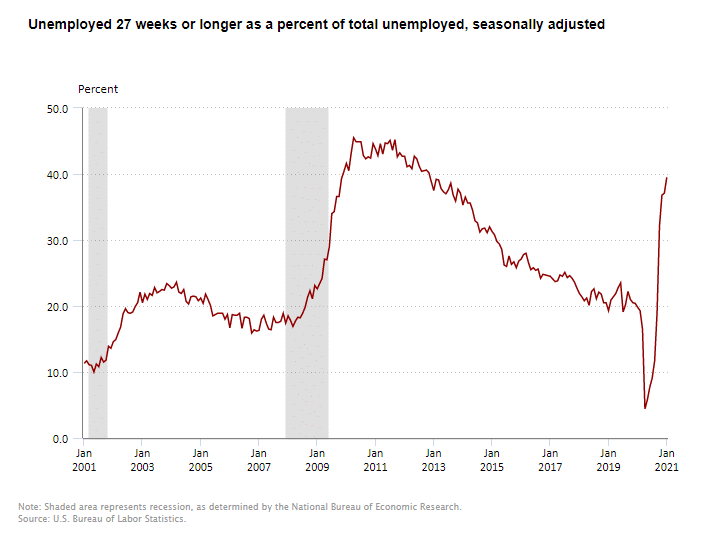
Labor Force Participation Rate
Even though Unemployment was in record low territory for quite some time, it wasn’t until January and February 2020, that the LFPR was finally able to claw its way back to 63.4%, its highest level since 2013.
Then COVID decimated all those gains dropping the LFPR down to 60.2% in April. In May it began to rebound and in June the LFPR was able to bounce back a little more to 61.5%, it fell slightly in July but this was probably due to people returning to the labor force rather than other factors. Over the last few months, the LFPR has bounced around between 61.4% and 61.7%. In January it fell again to 61.4%.
See Labor Force Participation Rate for more information.
If you would like to receive this monthly report and other article updates click here you can unsubscribe at any time.
Here are some articles you might enjoy in case you missed them:
Read more on UnemploymentData.com.
- How to Go Back to School as an Adult: The Steps Explained
- Create a Professional Resume
- How to Get a Job with No Experience
- Turning Unemployment to Success
From InflationData.com
- Price and Wage Changes since 2000
- Why Hasn’t the U.S. Dollar Experienced Hyperinflation?
- Using Risk to Combat Inflation
- The Price of Oil Denominated in Bitcoin
- How has Venezuela’s Bitcoin experiment Fared?
From Financial Trend Forecaster
- Top Financial Trends Shaping Banking
- The Death Of U.S. Shale Has Been Greatly Exaggerated
- China Ramps Up U.S. Crude Oil Imports
- Speed and Affordability: Cost of Internet Access Over Time
- New Technologies in the Oil and Gas Industry
- Spotting the Slide in Silver
- Market Participants are Extremely Bullish
- Why Most Investors Miss Major Stock Market Turns
- This High-Confident Trade Set-up Makes for Highly-Confident Traders
- Bond Market: “When Investors Should Worry”
From OptioMoney.com
- Smart Finance Moves: Questions to Ask Yourself Before You Buy a New Car
- Wealth Transfer: Estate Planning
- 5 Things to Consider When Managing Money in a Relationship
- Should You Buy a Second Home?
- Learning to Trade from Video Tutorials
From Your Family Finances

